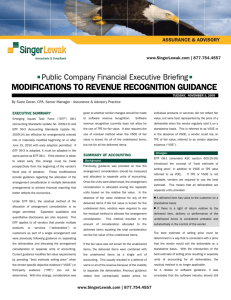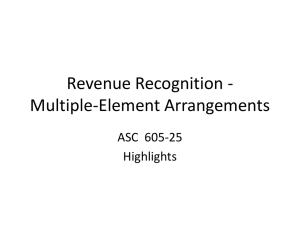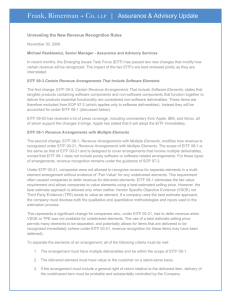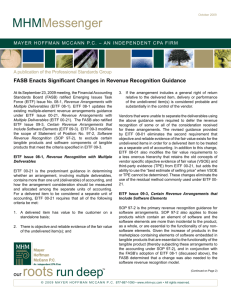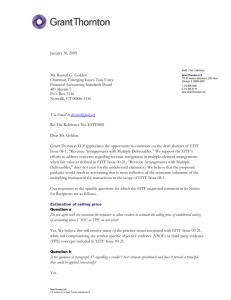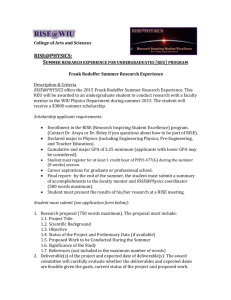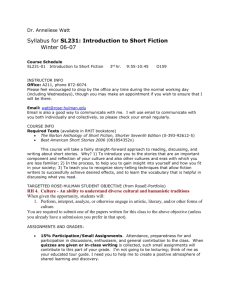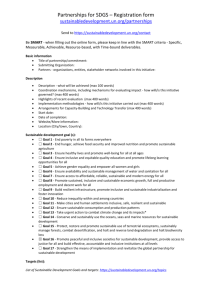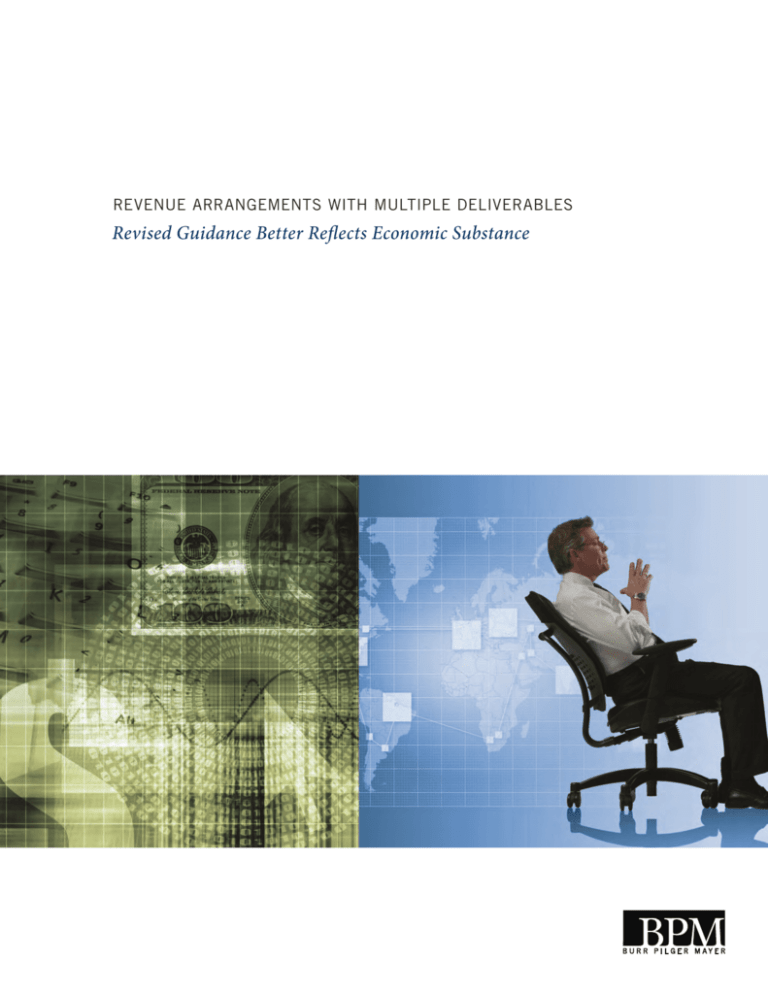
Revenue Arrangements with Multiple Deliverables
Revised Guidance Better Reflects Economic Substance
Executive Brief
• FASB recently issued EITF Issue Number 08-1, which modifies the way companies with multiple
deliverable arrangements will report revenue. The most significant change is the introduction of Relative Selling Price which replaces the old requirement to establish objective evidence of fair value.
• FASB also issued EITF Issue Number 09-3, which modifies revenue recognition guidance for tangible products sold along with essential software. This guidance eliminates the confusion that previously existed over how to account for these specific arrangements.
• The above changes in the rules surrounding revenue recognition will lead to an increased level of review and could possibly lead to quicker revenue recognition that better follows the economic substance over these types of arrangements.
EITF 08 -1
The Financial Accounting Standards Board (FASB) altered and updated the rules surrounding revenue recognition for multiple-element arrangements1, as a result of the final consensus reached
on EITF Issue No. 08-1, “Revenue Arrangements with Multiple Deliverables.”2 For purposes of this
white paper, we’ll refer to the new rules as EITF 08-1.
EITF 08-1 supersedes the existing guidance on such arrangements and is effective for fiscal periods
beginning on or after June 15, 2010. The changes made in this accounting standard update have
wide ranging ramifications for a multitude of companies in various industries, and companies should
give it fair consideration prior to adoption in order to avoid any unwelcome post-adoption conflicts.
FASB also revised the guidance surrounding what constitutes a software arrangement, which will be
discussed later in this white paper.
Multiple Deliverables are a Way of Life
It is a common business practice for companies to provide multiple products or services (“deliver-
“The changes made
in this accounting
standard have wide
ranging ramifications
for a multitude of
companies in various
industries…”
ables”) to their customers as part of a single arrangement. These arrangements can be provided
over multiple quarterly or even annual reporting periods. They may range from relatively simple
arrangements for the routine delivery of multiple products in one package (e.g., when a telecommunications carrier offers a cell phone at a certain price to any customer who agrees to a two year
service contract at the inception of the deal) to highly customized and inherently complex arrangements designed to provide an integrated solution to a customer’s business needs (e.g., when an IT
managed services company provides multiple technology solutions to various customers when no
two solutions are the same and the pricing of these solutions can be quite different).
1
As businesses continue to evolve with each passing year, companies’ products and service offerings
continue to become more complex in reaction to the needs of their customers. Furthermore, companies
are looking every which way to demonstrate value to their customers in the form of additional incentives or deliverables within an arrangement and in the form of varying sales terms and conditions,
including adjusting payment terms, which may not always coincide with the individual product or
service’s delivery date. Accordingly, it may not be apparent which payment, or specific portion of a
payment, matches an explicit deliverable included in an arrangement.
As these complex deals have become more commonplace, this in turn has increased the difficulty of
accounting for such transactions. The question becomes whether, and, if so how, to allocate the entire
arrangement consideration to the individual deliverables based upon an acceptable allocation method
“As businesses
continue to evolve
with each passing
year, companies’
products and service
offerings continue
to evolve as well…”
in the accounting guidance. In the past, this question, if answered incorrectly has led to restatements
in cases where the errors are found material. A misapplication of revenue recognition principles to a
multiple-element arrangement can be avoided by understanding this new guidance in detail.
The Shortcomings of the Old Guidance
Since it was issued and effective for new multiple element arrangements beginning in fiscal periods
beginning after June 15, 2003, EITF 00-21 experienced its fair share of challenges which the EITF is
trying to correct through the new guidance. For example, for some companies, there was difficulty in
determining the specific units of accounting, as EITF 00-21 did not include specific guidance on this topic.
However, the most difficult hurdle to overcome was that most companies were not able to determine
the objective fair value for each and every deliverable in an arrangement due to the lack of Vendor
Specific Objective Evidence (VSOE) or Third Party Evidence (TPE).
Determining Relative Fair Value
Under the old guidance, the arrangement consideration was allocated to each unit based on the
unit’s proportion of the fair value of all of the units in the arrangement using VSOE or TPE.
As using VSOE and TPE to determine a unit’s objective fair value can be very judgmental, multiple
allocation methods are acceptable for an arrangement’s consideration. In the absence of either one
of the fair value evidence criteria (VSOE or TPE) for any of the delivered items, and assuming the
objective fair value was available for all undelivered items, companies were then required to use the
residual method to allocate the arrangement consideration.
2
Under the residual method, the amount of consideration allocated to the delivered items equaled the
total arrangement consideration less the aggregate objective fair value of the undelivered items.
The VSOE or objective fair value of the undelivered elements was then deferred, and the residual or
difference between the total arrangement fee and the deferred amount for the undelivered elements
was recognized as revenue for the delivered elements.
If a company couldn’t determine the value of the undelivered items, then the delivered items were
required to be combined with the undelivered items, and revenue recognition was determined for the
deliverables as a single unit of accounting. In many cases, this one deliverable could represent
virtually all of the overall value of the deal. Many companies were forced to defer revenue for an
“Companies and
their many investors
claimed that the
revenue recognition of
multiple deliverables
under the existing
guidance distorted the
basic economics of
the transaction for a
variety of deals.”
entire arrangement in cases where they had already fulfilled their obligations for at least one of the
deliverables. Thus, companies and many investors claimed that the revenue recognition of multiple
deliverables under the existing guidance distorted the basic economics of the transaction for a
variety of deals.
New Guidance under EITF 08-1
new guidance
With the new EITF 08-1, the FASB is now relaxing the fair value requirements by introducing Relative
Selling Price (RSP), which allows a company to use the “best estimate of selling price” for determining
the selling price of a deliverable.
The new hierarchy for evidence of selling price is as follows:
• VSOE – Vendor specific objective evidence is still the most preferred criteria with which to establish
fair value of a deliverable. VSOE is the price of a deliverable when a company sells it on an open
market separately from a bundled transaction. This involves the accumulation of discrete sales of the
deliverable sufficient to prove that the price is fair as determined by the market for that deliverable.
“Relative Selling Price
(RSP) allows a company
to use the “best
estimate of selling
price” for determining
the selling price of
a deliverable.”
• TPE – Third party evidence is the second most preferred criteria with which to establish fair value
of a deliverable. The measure for the pricing of this criterion is the price that a competitor or
other third party sells a similar deliverable in a similar transaction or situation.
• RSP – Relative selling price is the price that management would use for a deliverable if the item
were sold separately on a regular basis which is consistent with company selling practices. The
clear distinction between RSP and VSOE is that under VSOE, management must sell or intend to sell the deliverable separately from the bundle, or has sold the deliverable separately from the bundle
already. With RSP, a company may have no plan to sell the deliverable on a stand-alone basis.
3
The residual method has been eliminated as an allocation method under the new guidance. This will
be a big transition for most companies as it was the most consistently applied method of allocation
of revenue to elements under the old guidance. In addition, a company must now clearly document
why VSOE does or does not exist, as well as its overall compliance with the fair value hierarchy.
The Process
After highlighting the significant differences between the new guidance and the old, let’s now examine
the process of accounting for revenue recognition over multiple element arrangements from begin-
units of accounting
ning to end under the new guidance.
Step 1: Determining the Deliverables or Units of Accounting and Standalone Value
The way of determining a deliverable or unit of accounting has not changed, though the definition of
a deliverable or unit of accounting is still not explicitly defined.
However, the new guidance does present some considerations and assistance in determining those
deliverables or units of accounting, which was missing from the existing guidance. In general, a
deliverable consists of the following characteristics:
1]
It is explicitly referred to as an obligation of the vendor in a contractual agreement.
2]
It requires a distinct action by the vendor even though an amount may not be assigned to that
action in the agreement.
The vendor’s failure to complete an action would result in a significant contractual penalty
or refund.
3]
4]
The inclusion or exclusion of the item in the arrangement reasonably would be expected to cause
the arrangement consideration to vary by more than an insignificant amount.
When determining what qualifies as a deliverable, it’s important to note that no two arrangements
are alike. The facts and circumstances applicable to a particular arrangement should be considered
when determining if an obligation represents a deliverable. Also, as more separation of multiple
“When determining
the deliverables, it’s
important to note that
no two arrangements
are alike.”
elements is expected under these new rules, it is extremely important to define these deliverables as
early as possible in the process so as to efficiently move forward in the fair value allocation process.
Once all of the deliverables are determined, each deliverable must have standalone value to a company upon delivery for it to qualify as a separate unit of accounting under EITF 08-1. This was less
of a focus under the existing guidance because the fair value threshold had been a common barrier
4
to separation. However, with the addition of the relative selling price threshold, this criterion is more
important now than ever before. The new guidance goes as far as defining standalone value for each
deliverable as follows:
“The delivered item or items have value to the customer on a standalone basis if they are sold
separately by any vendor or the customer could resell the delivered item(s) on a standalone basis.
In the context of a customer’s ability to resell the delivered item(s), this criterion does not require
“The new guidance
does not provide
detailed guidance on
how to best determine
an estimate of relative
selling price...”
the existence of an observable market for deliverable(s).”
As noted above, determining standalone value is based upon the facts and circumstances of the specific arrangement. Deliverables generally include all performance obligations imposed on a vendor by an
agreement. A deliverable may be an obligation to provide goods or to deliver services, a right, or a
license to use an asset, or some other vendor obligation that was bargained for as part of the arrangement.
Step 2: Determining Estimate of Relative Selling Price
The new guidance does not detail how to best determine an estimate of relative selling price, as
significant amounts of judgment are involved in the process. But, it does provide some specific examples. As relative selling price is a new concept in accounting guidance, here are some factors to
consider in determining the relative selling price for a deliverable:
• Market demand for a particular product/service
• Profit margins generally realized in
the marketplace/industry
• The existence of competitors and their effect on a particular product/service
• Overall state of the economy and current economic trends
• Customer’s internal costs of making
products or providing services themselves
• Internal profit objectives such as targeted or historical profit margins
• Pricing practices in providing discounts
• Internally demanded rates of return
• A product’s risk of obsolescence
As more separation of units is expected with the addition of this relative selling price method, here are
some challenges that companies will likely face in developing this relative selling price estimate:
• Introduction of a new product or service
• Inability to reasonably estimate estimate selling price on a “cost-plus” basis because primary costs are R&D
• Introduction of an existing product or
service to a new market, geographic region or customer type
• Unusual trends in supply or demand
5
• Product with generally high margins and significant variations in selling price
• New arrangements with unique terms not previously encountered by a company
• Products with a history of infrequent sales
• Urgent sales at a loss or sales to lure
future purchase commitments
rel ative sell
A key for companies as they implement the new guidance will be to create a process within its exist-
ing internal control structure to evaluate a contract’s deliverables and their fair value or relative
selling prices. If a product or service is dynamic and frequently changing due to customer demand
or obsolescence risk, then a company may need to revisit the relative selling price analysis
frequently. If a product or service is fairly standard and has been in existence for many years, then
a company may not need to revisit this analysis as often as possible. Thus, companies should begin
to discuss implementation procedures with their sales and accounting departments to ensure that
there are no surprises from an accounting perspective.
Example: A simple example illustrating the relative selling price method in comparison to the residual method. Facts:
• Total consideration: $2,000
• Two deliverables:
“All companies
should begin to
discuss implementation
procedures with the
sales department
and the accounting
department to ensure
that everyone is on
the same page.”
Delivered product (Estimate of selling price $1,200, no VSOE or TPE)
2] Undelivered services (VSOE is $1,000)
1]
New Guidance
Old Guidance
Relative Selling Price Method:
Residual Method:
$1,200 (delivered product selling price)
÷
$2,200 (aggregate selling price)
x
$2,000 (total consideration)
=
$1,091 Allocated to delivered product
$2,000 (total consideration)
$1,000 (undelivered services selling price)
=
$1,000 Allocated to delivered product
These aforementioned changes, though beneficial to the timing of revenue for many companies, may
bring more scrutiny to their accounting. Thus, a firm understanding of the adoption possibilities
under the new guidance is required along with a firm understanding of the new disclosure requirements in each company’s financial statements.
6
The following is a suggested timeline and adoption strategy for companies with regards to the
new rules:
Retrospective
Prospective
Early Adoption
Time Period
Beginning of all periods
presented
Fiscal years beginning on or
after June 15, 2010
Beginning of fiscal year
(if other than Q1,
retrospectively adjust to Q1)
Disclosures
Comply with ASC 250
[Statement 154]
disclosure requirements
Qualitative
If prospective other than
Q1, also disclose below
Application (Optional)
Application
Provide description of
change in allocation method
(Optional)
Effect on revenue
Provide description of
change in pattern of
revenue recognition
Effect on income
before taxes
Provide determination
of whether adoption will materially affect future periods
Effect on net income
Quantitative
Effect of the change for
appropriate captions
presented, etc.
Provide supplement
qualitative disclosures
Effect on earnings
per share
Additional Disclosure Requirements
With more multiple element arrangements expected to qualify for unit separation and more revenue
expecting to be recognized upfront upon delivery of certain deliverables, the required disclosures for
these arrangements have become more scrutinized as they have grown in importance. The new guidance aims to provide both qualitative and quantitative information about a company’s revenue
arrangements and the significant judgments made or any applicable changes in those judgments
that may affect the timing or amount of revenue recognition.
Specifically, here is what the new guidance is requiring for disclosure purposes:
• Nature of multiple-deliverable arrangements
• Significant deliverables within
the arrangements
• General timing of the delivery or
performance of service for deliverables
• Performance-, cancellation-, termination-,
and refund-type provisions
• Discussion of significant factors, inputs,
assumptions, and methods used in
determining selling price (whether VSOE,
TPE, or estimated selling price)
• General timing of revenue recognition
7
• Whether deliverables qualify as separate
units of accounting, and reasons if they
do not
• Effects of changes in either the selling price or the method or assumptions used to determine the selling price if significant
As each company implements the new guidance, it may be important to track revenue recognition
under both the old and new models for disclosure purposes as there are also various transition
“Overall, this new
guidance is very factsand circumstancesdriven.”
disclosures required under the new guidance (e.g. amount of revenue that would have been recognized in the current year if all arrangements were under the old guidance prior to amendment,
amount of revenue in the prior year that would have been recognized if all arrangements were under
the new guidance, etc.). Overall, this new guidance is very facts- and circumstances-driven.
Companies should be starting early to get a handle on the intricacies of this new guidance, and they
should start implementing internal controls over the processing of sales contracts and revenue
recognition based upon the new guidance.
Revised Guidance for Multiple Deliverables with
Essential Software
The FASB addressed a type of multiple element arrangement involving the sale of a tangible product
along with a software component that is “essential to the functionality” of the product (e.g. the sale
of a laptop computer with a software operating system embedded within).
The issue that arose was that many companies accounted for both the tangible product and the
software component under SOP 97-2, “Software Revenue Recognition” guidance, which historically
has had more stringent revenue recognition rules. To correct this, FASB finalized EITF Issue 09-3,
“Certain Arrangements that Contain Software Elements,”3 For purposes of this white paper, we’ll
refer to the new rules as EITF 09-3.
Going forward, arrangements in which “software components of tangible products are sold, licensed,
or leased with tangible products when the software components and non-software components of
“Going forward, products
with essential software
components to them
will be accounted for
under the new EITF
08-1 guidance…”
the tangible product function together to deliver the tangible product’s essential functionality” will
be accounted for under EITF 08-1 guidance for all elements of the deal (the non-software, essential
software, and undelivered elements).
Essential to the Functionality
If the software is considered non-essential, then it and its undelivered elements should be
accounted for under the existing software guidance in SOP 97-2. In this situation, only the tangible
product element is recognized under EITF 08-1.
8
Though “essential to the functionality” is not strictly defined (once again, the determination is
based upon facts and circumstances), consider these factors in making a determination:
• Tangible product infrequently sold without software – If sales of the tangible product without the
software elements are “infrequent,” a rebuttable presumption exists that software elements are
essential to the functionality of the tangible product. This is the most important factor in making
this assessment. The factor mentions “infrequent,” not “never” and as such, there is a level of
“…there is no strict
definition of “essential
to the functionality”…”
judgment involved that will have to be captured within a company’s internal control structure.
The best example for this factor is a personal computer with an operating system. If the computer
is regularly sold without the operating system, then the software is inside the scope of the software
guidance. If infrequently sold, then it is outside the scope (and in the EITF 08-1 guidance).
• Products with similar functionality – A vendor may sell products that provide similar functionality,
such as different models of similar products. If the only significant difference between similar
products is that one product includes software that the other product does not, the products shall
be considered the same product for purposes of evaluating the first factor above. This is related
to multiple product lines of the same product family.
• Separate sale of software – If a company sells software on a standalone basis and also sells
tangible products containing that same software, the separate sale of the software shall not
sof t ware
cause a presumption that the software is not essential to the functionality of the tangible product.
An example of this is the Microsoft Office Suite which often times is sold separately on the market
away from a new personal computer sale, but new laptop computers are sold frequently with the
Microsoft Office Suite embedded within the computer’s hard drive.
• Embedded software – Software elements do not need to be physically embedded within the tangible
product to be considered essential to the tangible product’s functionality. The software could be
installed remotely at another location.
• Non-software elements substantively contribute to tangible product’s essential functionality –
The non-software elements of the tangible product must substantively contribute to the tangible
product’s essential functionality. For example, the tangible product should not simply provide a
mechanism to deliver the software to the customer (e.g. memory stick or removable flash drive).
The aforementioned factors should help companies in determining whether or not their arrangements qualify for the software guidance scope exception under EITF 09-3.
9
Once the factors have been taken into consideration, the following process must be completed:
1]
Companies must separate non-software
components from software components
using the guidance in EITF 08-1.
3]
Companies must further separate multiple elements within non-software component
using EITF 08-1.
4]
2]
Companies must further separate multiple
elements within software components using
SOP 97-2.
Bifurcate undelivered items related to both
software and non-software components
based upon relative fair value.
The disclosure requirements under this new EITF issue are similar to the disclosure requirements
mentioned above under EITF 08-1.
Example: Here is an example taking into account this analysis.
Facts: Vendor offers box with core software that is always included with the box and is considered
essential to the box’s functionality. The customer requests additional application software which is
included 80% of the time with the box. Vendor offers post-contract customer support (PCS) on entire
arrangement. Lastly, the vendor offers a specified upgrade on the core software (no VSOE exists).
Here is a diagram that breaks out the process items 1 through 4 in detail:
Total Arrangement
(Issue 08-1)
Non-Software
Deliverables (Issue 08-1)
Box
Undelivered PCS
(Bifurcate)
Software Deliverables
(Software Guidance)
Application Software
Core Software
Specified Upgrade
(Allocate using ESP)
10
Conclusion
In conclusion, the new revenue recognition rules will be a challenge at first, but the process can be
a lot smoother with some advanced planning and thought. Here are some of the points to take away
from the new revenue recognition rules discussion above:
1]
During the implementation process, it will be key for companies to create a process within the
existing internal control structure to evaluate a contract’s deliverables and the fair value or relative
selling price of those deliverables. Companies should be starting early to get a handle on the intricacies of this new guidance, and they should begin implementing internal controls over the processing of sales contracts and revenue recognition based upon the new guidance.
2] All companies should begin to discuss implementation procedures with their sales and accounting
departments to ensure that everyone is on the same page.
3] During
the transition process, it will be necessary to track revenue recognition under both models
(the EITF 00-21 and EITF 08-1 models) for disclosure purposes as there are also various transition
disclosures required under the new guidance.
––––––––––––––––––––––––––––––––––––
1] Codified in ASC 605-25.
2] Codified by Accounting Standard Update (ASU) 2009-13.
3] Codified by Accounting Standard Update (ASU) 2009-14.
11
About BPM and the Author
BPM is a leader in assurance, tax, consulting, and wealth advisory services. Our staff of experts
constitutes more than 375 people who are united by a culture of trust and dependability and a commitment to understanding the needs of our clients. For more information, visit www.bpmcpa.com.
Nick Steiner, Shareholder in Assurance, is the leader of BPM’s Technology Industry Practice.
You can reach Nick at 408.961.6375 or nsteiner@bpmcpa.com.
© 2013 BPM Inc. All Rights Reserved.
This publication contains information in summary form and is intended for general guidance only. It is not intended to be
a substitute for detailed research or the exercise of professional judgment. Neither BPM nor any other member of the


